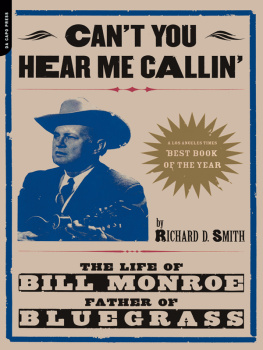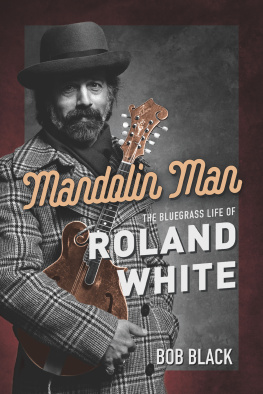C ANT Y OU
H EAR
M E
C ALLIN
A LSO BY R ICHARD D . S MITH
Bluegrass: An Informal Guide Images
of America: Princeton
C ANT Y OU
T HE L IFE OF
H EAR
B ILL M ONROE,
M E
F ATHER OF B LUEGRASS
C ALLIN
R ICHARD D . S MITH
This book is respectfully dedicated to
Rosetta Monroe Kiper,
a grand lady I am proud to call friend.
Copyright 2000 by Richard D. Smith
All rights reserved. No part of this publication may be reproduced, stored in a retrieval system, or transmitted, in any form or by any means, electronic, mechanical, photocopying, recording, or otherwise, without the prior written permission of the publisher.
Printed in the United States of America.
Text Designed by Chris Welch
Cataloging-in-Publication data for this book is available from the Library of Congress.
First Da Capo Press edition 2001
Reprinted by arrangement with Little, Brown and Company
ISBN 0-306-81054-9 ISBN-13: 978-0-306-81054-1
eBook ISBN: 9780786731169
Published by Da Capo Press
A Member of the Perseus Books Group
www.dacapopress.com
Da Capo Press books are available at special discounts for bulk purchases in the U.S. by corporations, institutions, and other organizations. For more information, please contact the Special Markets Department at the Perseus Books Group, 11 Cambridge Center, Cambridge, MA 02142, or call (617) 252-5298.
Talking to him was like talking to poetry. Just a few words or a line, if you listened closely to them, those words could mean so much. Just a simple statement could have such depth. Just like his music.
People ask me what it was like talking with Bill Monroe. It was like speaking to a poem that spoke back.Kim Koskela
Bill Monroe is one of the ultimate feel players. If he played it, its because he felt it.Sam Bush
People say youve never met anyone like Bill Monroe. Theyre right.Mike Seeger
* I NTRODUCTION *
On the night of October 2, 1954, two future legends of American popular music faced each other backstage at the Grand Ole Opry in Nashville, Tennessee. Onea skinny, nervous kid from Memphis named Elvis Presleywas offering apologies to the othera taciturn and physically powerful Kentuckian named Bill Monroe.
At the time, Presley was an up-and-coming singer making a guest appearance on the popular country music stage show and radio broadcast. But Monroe was a star and one of Presleys idols, a fifteen-year Opry veteran backed by a hot band called the Blue Grass Boys. Elvis might have had gyrating hips, but he had firmly planted feet: one in black rhythm and blues, one in white country (or hillbilly) music. And Bill Monroe was Elvis Presleys favorite hillbilly singer.
On July 6, while recording their first single for Sun Records, Elvis and his sidemen had transformed Monroes sentimental waltz Blue Moon of Kentucky into a rousing 2/4-time rocker that was a near parody of the original. To Presleys immense relief the composer was gracious about the liberties taken with his song.
If it helps your career/ Monroe said, Im for it one hundred percent.
When each man left the Ryman Auditorium that evening, much was ahead of him. Presley would of course be elevated to the status of a nearly mythical cultural icon. But Monroes life would continue to be extraordinarily eventful and his influence even more multifaceted than Presleys. Indeed, Bill Monroe would become the most broadly talented and broadly influential figure in the history of American popular music.
This assessment is supported by the facts of Monroes career. Certainly, Elvis Presley, Louis Armstrong, and Hank Williams had greater specific impacts as, respectively, a rock star, a jazz instrumentalist, and a country singer-songwriter. But Monroes varied influence as a singer, instrumentalist, composer, and bandleader was felt in early commercial country music, rockabilly and later rock, the folk music revival, contemporary country, and, of course, bluegrass. In addition to scores of famed musical disciples, Bill Monroe was admired by artists as prominent (and diverse) as Bob Dylan and Frank Sinatra.
Born in 1911, this youngest child of a large Kentucky farming family grew up in an essentially nineteenth-century world. He was surrounded by ancient folkways that had survived among settlers of the southern hills. He benefited in childhood from the economic exploitation of resource-rich Kentucky, and the interplays of white and black cultures. Then he was thrust into the twentieth century as part of the great southern exodus to northern industry, coining to know the role of country music as a cultural anchor for rural people transported to the cities.
By the time he met Presley, he had been a member of one of the most successful country duet acts of all time, the Monroe Brothers. He had formed his own band (named in honor of his home state) and won a spot on the Opry. He was present when the radio and record businesses par-ented the mass media age and country music evolved from grassroots novelty into multibillion-dollar entertainment industry.
His chief claim to fame has been as the creator of a highly personal and instantly recognizable style of acoustic country music. It flowered from the grafting of multiple musical roots and branchessquare dance fiddle tunes and modal ballads rooted in British Isles traditions, African-American blues, southern Protestant church harmonies, Tin Pan Alley pop elements, and the sheer creativity of Monroe and scores of his innovative sidemen.
This music was eventually termed bluegrass in honor of Monroes band the Blue Grass Boys. It featured high lead vocal lines and close harmonies backed by fiddle, mandolin, banjo, guitar, and upright bass played in surging, anticipating rhythms within a jazz-influenced improvisational format. So potent was this combination that bluegrass began to take on an identity beyond that of Bill Monroes personal band sound. (The term itself has been used erroneously as a generic name for centuries-old mountain music.) Later, Monroe would be rightly lauded as the Father of Bluegrass and the only person to createnot just dominate but wholly createa distinctive musical genre.
If you really watch it close, look at all of it, it makes a powerful music, he said with pride and honesty. I have never heard any music I thought would beat it, myself.
Monroe distanced himself from many country artists who had preceded him. He eschewed the old hayseed-with-a-jug and dressed band members in sober ties and dress shirts, polished boots, and neatly pressed slacks. Bluegrass was traditional-style music made professional.
Through the decades, a stint in the Blue Grass Boys became the equivalent of an advanced degree program (or a boot camp) for aspiring entertainers. (Former sideman Doug Green recalls that all the time he played with Bill, he felt like he was walking on airand walking on eggs. Numerous Monroe protgs formed their own groups performing in his style. The most famous were Lester Flatt and Earl Scruggs, respectively the guitarist-lead vocalist and the banjo picker who were core members of the classic Blue Grass Boys lineup of the late 1940s. They left to form the tremendously successful partnership of Flatt and Scruggs & the Foggy Mountain Boys, gaining crossover fame in the 1960s by contributing music to the soundtracks of the Beverly Hillbillies television show and the movie Bonnie and Clyde. Monroe brooded for years over what he considered creative theft of his sound until hindsight showed that he had been honored by imitation.








